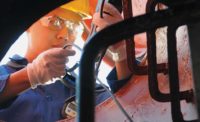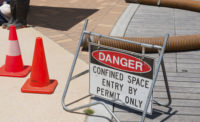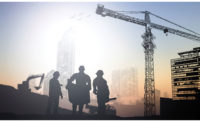Construction work in confined spaces
OSHA’s standard confronts constantly changing conditions

On May 4, 2015, OSHA issued a new standard for construction work in confined spaces, which will be effective starting August 3, 2015. Confined spaces can present physical and atmospheric hazards that can be avoided if they are recognized and addressed prior to entering these spaces to perform work.
“This rule will save lives of construction workers,” said OSHA Assistant Secretary of Labor Dr. David Michaels. “Unlike most general industry worksites, construction sites are continually evolving, with the number and characteristics of confined spaces changing as work progresses. This rule emphasizes training, continuous worksite evaluation and communication requirements to further protect workers’ safety and health.”
The new standard, Subpart AA of 29 CFR 1926, will help prevent construction workers from being hurt or killed by eliminating and isolating hazards in confined spaces at construction sites similar to the way workers in other industries are already protected.
Training requirements
Employers must provide training to each employee whose work is regulated by this standard, at no cost to the employee, and ensure that employees possess the understanding, knowledge and skills necessary to safely perform the duties assigned under this standard. Training must result in an understanding of the hazards in the permit space and the methods used to isolate, control or in other ways protect employees from these hazards. For employees not authorized to perform entry rescues, it must convey the dangers of attempting such rescues.
Affected employees must be trained:
- In both a language and vocabulary that the employee can understand;
- Before the employee is first assigned duties under this standard;
- Before there is a change in assigned duties;
- Whenever there is a change in permit space entry operations that presents a hazard about which an employee has not previously been trained; and
- Whenever there is any evidence of a deviation from the permit space entry procedures required by paragraph §1926.1204(c) of this standard or there are inadequacies in the employee’s knowledge or use of these procedures.
The training must establish employee proficiency in the duties required by this standard and must introduce new or revised procedures, as necessary, for compliance.
The employer must maintain training records to show required training has taken place. Training records must contain each employee’s name, the name of the trainers, and the dates of training. Documentation must be available for inspection by employees and their authorized representatives, for the period of time the worker is employed by that employer.
Common questions
To assist employers in complying with the new standard, here are some frequently asked questions and answers outline by on its website at www.osha.gov:
How do I know whether to follow the general industry or construction confined space rule?
If you are doing construction work – such as building a new structure or upgrading an old one – then you must follow the construction confined space rule.
Why did OSHA believe that the former standard needed to be changed?
Previously the only requirement for confined spaces in construction was training. OSHA concluded this was inadequate as injuries and fatalities continued to occur.
How does the new final rule differ from the rules that previously applied to construction work performed in confined spaces?
The rule requires employers to determine what kinds of spaces their workers are in, what hazards could be there, how those hazards should be made safe, what training workers should receive, and how to rescue those workers if anything goes wrong.
Where can I find the final rule for Confined Spaces in Construction?
Information on the new confined spaces standard can be found on the Confined Spaces page at www.osha.gov/confinedspaces/index.html.
How can I contact OSHA if I have questions about the final rule?
For compliance assistance regarding application of the final rule contact: Directorate of Construction, Room N3468, OSHA, U.S. Department of Labor, 200 Constitution Avenue NW, Washington, DC 20210; telephone (202)-693-2020 or fax (202)-693-1689.
Who is affected by Subpart AA?
All construction employers whose workers may be exposed to confined space hazards.
Do I need to do anything if there are permit spaces at the worksite, but my employees will not need to enter the permit space?
Yes, you must take effective steps to prevent your employees from entering the space.
If I hire a contractor (or subcontractor) to do work in a confined space do I have any responsibilities?
Yes, controlling contractors and host employers must discuss spaces on the site and their hazards with entry employers and each other before and after entry (see question below).
Tell me more about the conversations between host employers, controlling contractors and entry employers.
The rule makes the controlling contractor, rather than the host employer, the primary point of contact for information about permit spaces at the work site. The host employer must provide information it has about permit spaces at the work site to the controlling contractor, who then passes it on to the employers whose employees will enter the spaces (entry employers). Likewise, entry employers must give the controlling contractor information about their entry program and hazards they encounter in the space, and the controlling contractor passes that information on to other entry employers and back to the host. As mentioned above, the controlling contractor is also responsible for making sure employers outside a space know not to create hazards in the space, and that entry employers working in a space at the same time do not create hazards for one another’s workers.
The above diagram shows the information flow and coordination between these employers
What standard should I follow if my workers are doing construction AND general industry work in confined spaces?
An employer whose workers are engaged in both construction and general industry work in confined spaces will meet OSHA requirements if that employer meets the requirements of 29 CFR 1926 Subpart AA - Confined Spaces in Construction.
Twenty-seven states and territories have their own OSHA-approved safety and health plans; will those states be required to adopt the new standard?
Yes, Twenty-two states or territories currently operate their own OSHA-approved State Plans (covering private sector and state and local government employees), and five additional states and one territory (Connecticut, Illinois, New Jersey, New York and the Virgin Islands) operate plans that cover state and local government employees only. State Plans have and enforce their own occupational safety and health standards that are required to be at least as effective as OSHA’s. Many State Plans adopt OSHA’s standards identically, but some State Plans may have different or more stringent requirements.
Looking for a reprint of this article?
From high-res PDFs to custom plaques, order your copy today!






